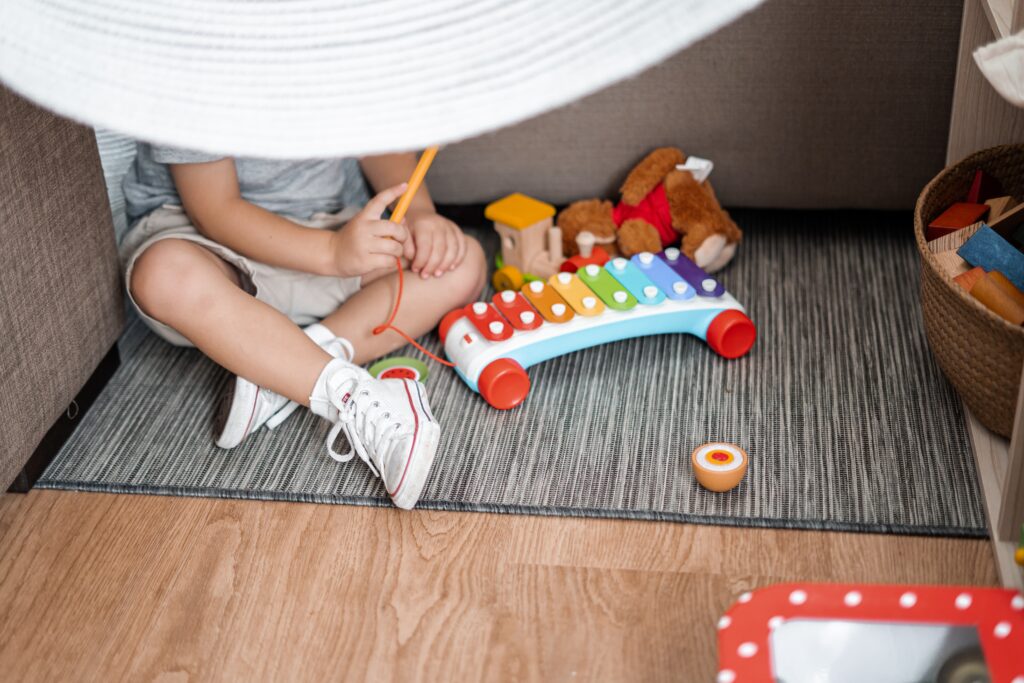Is It Time to Drop the Nap?
Let’s talk about your toddler’s naps. Was your toddler an amazing napper and now all of a sudden they are protesting their nap or they just simply don’t fall asleep? You may be thinking, no! I’m not ready to say goodbye to naptime. Don’t panic just yet, keep reading.
I have had a lot of parents asking about an 18-month sleep regression and yes, there can be a sleep regression around 18-24 months. Like other sleep regressions that occur, this one revolves around a milestone, just like crawling, learning to stand up and walking.
So which milestone happens around this age? Is your toddler talking up a storm? Putting together sentences and repeating everything you say? Yup! This language explosion has their brain working overtime processing all of this speech which can cause problems with their sleep along with tantrums. This language acquisition can also show up later around 2.5-3 years of age.
There are a few different scenarios that can happen during this regression. You may find that you don’t have a problem with naps at all, that in fact, your toddler will happily sleep for 2-3 hours at naptime, but you are noticing a problem with their nighttime sleep. They may be taking longer to fall asleep at night and waking up early in the morning.
As your child gets older, whether we like or not, their sleep needs change and they don’t need as much daytime sleep. My 2-year-old just went through this transition, and as much as I hated to shorten her amazingly lengthy afternoon nap, I hated early morning wakings even more!
So, if you are seeing this happen you need to start capping their afternoon nap to 60-90 minutes. You must do that consistently for at least 10-14 days to see improvements in their nighttime sleep. Once your little one is falling asleep quicker and sleeping into her usual time, you will have confirmation of her new shortened naptime, so stick with it.
You could be experiencing a totally different situation, especially if your toddler is over 2.5-3 years old. Your toddler may happily lay down, but never fall asleep. They spend their nap talking to themselves. This can play out day after day but, you should continue to lay them down for a nap at their usual time.
If naptime has been consistent for a while now, it may just be a matter of timing. They may need a later naptime. You can try pushing the nap to 12:30/1:00 pm (awake no later than 2:00/2:30 pm), but I wouldn’t push it too much later or it will affect bedtime.

Make sure to get some time outside in the sun and fresh air in the morning to tire them out before their nap. If your child doesn’t nap, always make sure to bring bedtime forward to avoid overtiredness. On these days it may help to offer them some fruit later in the afternoon and expect them to be a bit grumpy.
So what do you do if your child protests naptime and is kicking and scream in their crib or bed? Your response all depends on whether your child will stay put. You want to try and keep them there for that hour, ignore the behavior and give them their space. I’m sure you want your quiet time to yourself as well. If they are in a bed or can climb out, you may need to get a little more creative. You can read some suggestions in this blog post.

Continue to offer the nap and after this language surge is over, your child will have mastered this new skill and get back into their nap routine. After a week or two your child will most likely be napping happily again.
If it’s been 2-3 weeks and there are no changes, you may consider it’s time to drop the nap. Especially if your child is still protesting after this period of time. This transition to no nap generally happens between the ages of 3 and 5.
Now, some parents really count on that nap to get things done, especially if you are working from home. I always recommend capping the nap before dropping it completely. But if nighttime sleep is being jeopardized due to the nap, it’s time for it to go. Nighttime sleep is very restorative, more so than daytime sleep and there may be no saving the nap without negatively affecting your child’s sleep overall.

Once you decide to drop the nap you want to start implementing “quiet time” when your child would usually be napping. This will encourage your child to play quietly and independently while also giving you a much-needed break.
Bring some activities to their room and explain that they can play quietly until the timer goes off. It helps if these activities are only used for quiet time. Set a timer starting with 30 minutes, working towards an hour and enforce this time limit with your child. They must stay in their room until the timer goes off. Keep the lights in the room dim, daylight works great if the sun is out, try to avoid bright lights.
By keeping the lights dim you may find on some days that your child falls asleep and that’s okay! If you find your child crashing later in the day offer them a snack and some outside time to get them through until bedtime. Fruit is a great option, the natural sugars will give them a boost.
Remember, you also want to move bedtime earlier during this transition to ensure they get 12 hours of nighttime sleep (based on their usual wake up time). It can take them 4-6 weeks for their body clock to fully adjust to this new schedule. If you are having trouble with your child’s sleep, schedule a sleep evaluation call today!


3 thoughts on “Is It Time to Drop the Nap?”
Pingback: Get Your Toddler to Stay in Bed - Happily Ever After Sleep
Pingback: Prepare to "Fall Back" - Happily Ever After Sleep
Pingback: Time to "Spring Forward" - Happily Ever After Sleep
Comments are closed.